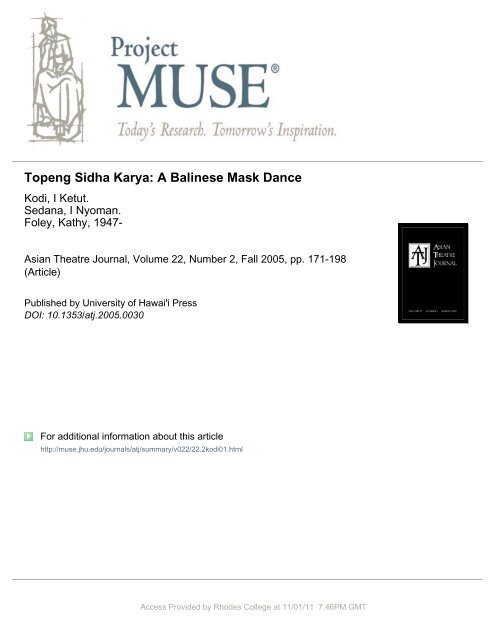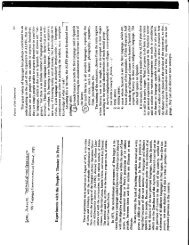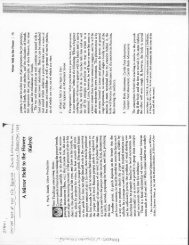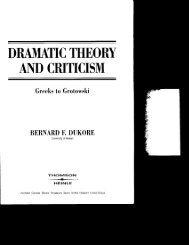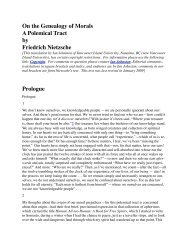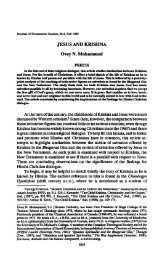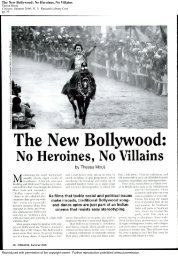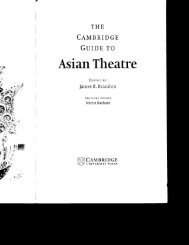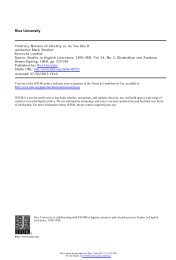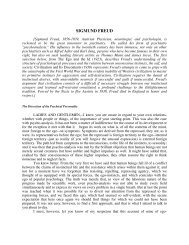Topeng Sidha Karya: A Balinese Mask Dance - Yavanika
Topeng Sidha Karya: A Balinese Mask Dance - Yavanika
Topeng Sidha Karya: A Balinese Mask Dance - Yavanika
- No tags were found...
Create successful ePaper yourself
Turn your PDF publications into a flip-book with our unique Google optimized e-Paper software.
<strong>Topeng</strong> <strong>Sidha</strong> <strong>Karya</strong>: A <strong>Balinese</strong> <strong>Mask</strong> <strong>Dance</strong>Kodi, I Ketut.Sedana, I Nyoman.Foley, Kathy, 1947-Asian Theatre Journal, Volume 22, Number 2, Fall 2005, pp. 171-198(Article)Published by University of Hawai'i PressDOI: 10.1353/atj.2005.0030For additional information about this articlehttp://muse.jhu.edu/journals/atj/summary/v022/22.2kodi01.htmlAccess Provided by Rhodes College at 11/01/11 7:46PM GMT
play<strong>Topeng</strong> <strong>Sidha</strong> <strong>Karya</strong>: A <strong>Balinese</strong><strong>Mask</strong> <strong>Dance</strong>Performed by I Ketut Kodi with I Gusti Putu Sudarta,I Nyoman Sedana, and I Made Sidia in <strong>Sidha</strong> <strong>Karya</strong>,Badung, Bali, 16 October 2002Transcribed by I Ketut Kodi; translated by I Nyoman Sedanaand Kathy Foley; introduced by Kathy FoleyAfter a terrorist bomb exploded in the Sari Club at Kuta Beach, Bali, in October 2002,a topeng performance of <strong>Sidha</strong> <strong>Karya</strong> (literally “completing the ritual work”) waspresented by I Ketut Kodi and other faculty members from STSI-Denpasar, the IndonesianUniversity of the Arts. The mask dance performance, held at the village of <strong>Sidha</strong>Kaya in Badung, Bali, was an exorcistic response to the terrorist attack and probed<strong>Balinese</strong> responses to the event. The introduction gives background on the story andanalyzes the way the narrative reflected both current social issues and traditional <strong>Balinese</strong>philosophy.I Ketut Kodi is a member of the Padalangan (Puppetry) faculty at ISI, formerlySTSI-Denpasar. He is a noted topeng dancer and a puppeteer who performs frequentlyin <strong>Balinese</strong> ceremonial performances as well as internationally. He is both atopeng master and a dalang of shadow puppetry. He is one of the first master performersof these arts with a formal education through the tertiary level.I Nyoman Sedana is a member of the Padalangan Department at ISI, formerlySTSI-Denpasar and Secretary of Research and Community Service Division for theinstitution. He completed an MA at Brown University and a PhD at the University ofGeorgia. His articles have appeared in Asian Theatre Journal, Asian Music, andPuppetry International. He performs <strong>Balinese</strong> puppetry and other arts in Bali andinternationally.Kathy Foley is a professor of theatre arts at University of California–Santa Cruzand editor of Asian Theatre Journal.Support for this work was provided by AMINEF-Indonesia via a Fulbright SeniorResearch Scholar Grant, UCSC Committee on Research, and Arts Research Institute.The performance was recorded by Dewa Made Darmawan of ISI.“<strong>Sidha</strong> <strong>Karya</strong>” literally means “the one who accomplishes theritual work.” In this essay the figure’s name will appear in normal fontAsian Theatre Journal, vol. 22, no. 2 (Fall 2005). © 2005 by University of Hawai‘i Press. All rights reserved.
172 Kodi et al.when referring to the character/mask or the place named after himand be italicized when discussing the story/play. <strong>Sidha</strong> <strong>Karya</strong> is thefinal mask presented in a ritual topeng (mask dance) performance fora <strong>Balinese</strong> ceremony. Every auspicious day, topeng dancers from allover the island engage in multiple performances that conclude withthis story, during which the dancer assumes a priest-like function. Atthe conclusion of the presentation the dancer says Sanskrit prayersand scatters rice and coins to the four directions, ensuring an auspiciouscompletion to the ceremony. Slattem and Schraub (2003:33–34), Emigh (1996: 148–153), Dunn (1983: 71–80), and Bandemand deBoer (1981: 54, 60) have discussed the <strong>Sidha</strong> <strong>Karya</strong> story, notingthe odd blend of demonic and divine within the character. Thisperformance by I Ketut Kodi and other faculty members from theUniversity of Arts in Denpasar, presented after the 2002 Bali bombexploded at Kuta Beach, gives the story in a more developed dramaticform than is usual. The mask always dances, but it is often a solo number,and little about a failed temple ceremony is included. This performancegives insight into both this well-known ritual story and howit was molded this time to respond to current social and political situations.Its humorous approach to its subject will disrupt Western expectationsof exorcism. Humor and clowning are not just secular entertainment.In Bali, the holy and slapstick comingle in improvised formssuch as topeng.The performance is like all previous versions of <strong>Sidha</strong> <strong>Karya</strong> inthat it presents a visitor who is wrongly rejected but then is honoredand embraced. However, each performance is also unique in that itresponds to the particulars of the audience. <strong>Balinese</strong> artists explainthe eternal variation within a set narrative by explaining that a performermust always take into consideration desa (village), kala (time),and patra (situation) in improvising a particular rendition. Thus,though the narrative is set, the performer, in terms of his presentationof the story, will make reference to the specific situation in the placehe is performing and the events of the current time. This introductionwill first give the general background on this important story that isknown and understood by all <strong>Balinese</strong>, and then discuss some of thechanges that the performers made to respond to the particular placeand time.General BackgroundThe story is simple: King Watu Renggong, a sixteenth centurymonarch of the Kingdom of Gegel who presides over the <strong>Balinese</strong>“golden age,” is holding a ceremony at the main <strong>Balinese</strong> shrine,Besakih Temple, to pacify the bhutakala, or demonic forces. A ragged
TOPENG: SIDHA K ARYA 173old man from overseas, Brahmana Sangkya, shows up to help with theceremony and is kicked out of the august proceedings. Immediatelycrops fail, people fall sick, and everyone turns against each other. Theking, like Oedipus, must find who is culpable to save the kingdom.Remembering the old Brahman he ordered beaten, the king realizesthat he himself has doomed the proceedings. The old outcast is actuallythe king’s spiritual brother, the son of the priest who helped installWatu Renggong’s father as monarch. Brahmana Sangkya is found andbrings the ceremony to completion by casting rice of four colors to thefour directions. He takes the name Brahmana <strong>Sidha</strong> <strong>Karya</strong>, meaning“the Brahman who accomplishes the ritual work.” His presence via hismask will be required at all ceremonies from that time hence. Often(though not in this particular presentation) he temporarily seizes achild from the audience, causing much excitement and laughter(Emigh 1996: 170).Some significant points of the story are the following. (1) <strong>Sidha</strong><strong>Karya</strong> represents a potentially dangerous power that comes from outsidethe system that must be accommodated by the system. (2) Theiconography of the mask with its fangs and leering grin is related tothe demonic, yet <strong>Sidha</strong> <strong>Karya</strong> is acknowledged as a protector. (3) Theperformance itself is a “mask,” shielding the ritual action that is executedby the priest, for the drama serves as a lure, presenting sound,movement, and story that cause viewers and demonic spirits to payattention to the performance and ignore the crucial ritual actionbeing silently executed by the pedanda (priest) in another part of thesame space. (4) The story models the relations of ruler, priest, and thepeople, where all must work together for a successful outcome.To sum up these points, danger is outside and its look isdemonic but it can be controlled, and art gives the threatening presencea place of spiritual recognition in the structure. Let me addressthese ideas in greater detail.Power from Outside that Must Be AcknowledgedThis performance took place at the <strong>Sidha</strong> <strong>Karya</strong> Temple inBadung, which is fifteen minutes by car from Kuta, the tourist centerand the site of the bomb that rocked the island economy. It is to this<strong>Sidha</strong> <strong>Karya</strong> temple that groups sponsoring any ceremony must cometo get the colored rice used in the <strong>Sidha</strong> <strong>Karya</strong> play/ritual that accompanieseach ceremony across the island. This temple is where this dangerousoutsider-priest who is both antagonist and hero of the <strong>Sidha</strong><strong>Karya</strong> story has been given a ritual abode in the sacred geography ofthe island.Both <strong>Sidha</strong> <strong>Karya</strong> and Kuta are in the southern part of the
174 Kodi et al.island, close to the sea from which turbulence and illness are thoughtto rise. As Michel Picard in Bali: Cultural Tourism and Touristic Culturenoted, “Kuta is in the lowlands on the coast, downstream toward thesea (kelod), associated with demons and pollution. In the cosmic perspective,it is appropriate that the tourists—who like the demons, areperceived as stupid, red-faced, hairy, and crude—are for the most partinstalled by the sea” (1996: 89). The <strong>Sidha</strong> <strong>Karya</strong> character, and all theoutsiders, traders, and tourists who come to the island, are forces thatwork on the cultural and ritual life of the island, which is largely livedout in temples, courts, and villages that rise on the volcanic slopesabove.The play, as presented here, is an examination of outsider anddisrupting forces, represented by <strong>Sidha</strong> <strong>Karya</strong>. These are forces thatcontemporary <strong>Balinese</strong> must deal with to realign their culture, even asthey are traumatized by the withdrawal of tourist dollars in the aftermathof the bomb. The blast forced <strong>Balinese</strong> to question the easyingress that the Javanese terrorists had to the island, and many soughtto reexamine the political decisions that left the island vulnerable.The <strong>Balinese</strong> border could not be closed because Bali is a part of theRepublic of Indonesia, but as a Hindu island in a nation that is 95 percentIslamic, they were targeted by Islamic fundamentalists. The performerraised the question of the future: should Bali push for separationfrom the republic, joining other separatist movements in Acehand Papua? Such an idea is sometimes aired in Bali; however, the performershere pass quickly from the political situation to the larger issuethat the attack represents—a metaphysical failure. The outside forcethat encroaches on Bali cannot simply be dismissed as demonic andexternal. It needs to be understood as linked to core <strong>Balinese</strong> values.The Kingdom of Gegel, ruled by Watu Renggong and with Besakih,the Mother Temple, represents the <strong>Balinese</strong> inner core. This areais high on the slopes of Gunung Agung, the great volcano that is theaxis of the island. Kaja-kelod (mountain-sea) directionality informs <strong>Balinese</strong>thinking, village layout, architecture, and performance. WatuRenggong, with his refined face, chiseled teeth, and mountain abode,is clearly the divine ancestor. He dances in a refined style and is theforbearer of all the <strong>Balinese</strong> kings, but his power is limited. <strong>Sidha</strong><strong>Karya</strong>, with his big eyes, grinning face, and fangs, has sea and shoreconnections. He dances in rough style and is said to come fromKeling, which may be Madura, Java, or even Eastern India, accordingto which version of the story you follow. His less socialized ways arepotent and must be both appreciated and placated.In this dichotomization of insider <strong>Balinese</strong> and outsider fromover the seas, we see an iteration of the <strong>Balinese</strong> concept of rwu
176 Kodi et al.Iconography of the <strong>Mask</strong>The <strong>Sidha</strong> <strong>Karya</strong> mask (see Plate 8) may be white or black. Somemasks have large teeth and wide grin. Others have fangs, a featurenormally associated with demons. Bushy eyebrows, a moustache, andunruly hair are other elements the figure shares with coarse, demoniccharacters. A representation of the third eye in the middle of the foreheadmay show the power of the character. While iconograpically thecharacter looks a lot like a demon, narratively we know that this is ahigh-class Brahman.In <strong>Balinese</strong> performances the most powerful masks are not therefined and pretty ones. Images that jar and disturb are favored. Themost powerful masks—<strong>Sidha</strong> <strong>Karya</strong> in topeng and Rangda in calonarang(see Emigh 1996: 60–69)—tend to be images of the demonic, butimages that have narratively been defanged by placing them within astory structure of curing or exorcism. <strong>Balinese</strong> performance allows thedemonic masks room to manifest in a prophylactic way.Performance <strong>Mask</strong>ing RitualThe process of art is one of substitution. The dance of <strong>Sidha</strong><strong>Karya</strong> diverts viewers’ attention from the Hindu priest’s ceremony thathappens simultaneously. The presence of the topeng cause viewers (anddemons) to focus on the music, dance, joking, and story that mask theHindu priest’s ritual action. <strong>Topeng</strong> is a sensual stand-in for the moreabstract action occurring in the spiritual realm.This brings us to the concepts of sekala, the seen world, andniskala, the unseen world. These two realms seem discrete. But in actualitythey are interlinked. The topeng actor is in charge of sekala. Hebusily points out the meanings of the ceremony and clarifies how theepic time of the story (Watu Renggong’s ceremony) relates to our hereand now (an exorcism for the Bali bomb). He eliminates boredom andmakes sure everyone has a laughing good time.Meanwhile, in the same space, the pedanda says his mantra insilence and creates the needed holy water via bell ringing, subduedmudra (hand gestures), and ritual acts. The pedanda is in charge of niskala.His action is primarily within the spiritual realm. He uses symbolicelements—barely audible mantras, hand gestures, and ceremony—togive human needs a voice in the world where gods and ancestors dwell.The ideas that inhere in the priest’s abstract universe are pulledout and writ large in the work of the topeng master. Using humor, helets the demonic play and gives it proper recognition. He awards theunknown outsider with his new name, <strong>Sidha</strong> <strong>Karya</strong>, and defines hisongoing role inside the system. The outcast is recast as the protector
TOPENG: SIDHA K ARYA 177of the island. The topeng dancer’s action is primarily within the physicalrealm and, therefore, it is appropriate that he uses the elementsthat appeal to our senses—music, dance, comedy, and political commentary—togive spiritual ideas a home in the here and now.Story is potent in that it allows us to control and contain reality.Narrative creates a structure that naturalizes the alien into the familiarand recalibrates the demonic into the comic. This is the functionof the bondres (clown) scenes in topeng where performers introducenew comic characters of their own invention. The pompous officialcontrolling everyone (Bondres Senggap), the one whose seems to misspeakbut actually may be smart (Bondres Wus)—both are graftedcomfortably into the existing story’s order.The topeng dancer’s artistic control exerts a kind of sympatheticmagic over life. Humans and demons, given their limited imaginationsand short attention spans, are easily subverted by the power of narrativeand the subterfuge of art. Danger and disruption are exorcisedfrom the everyday and embedded in a narrative that diffuses theirimpact.Relations of Ruler, People, and PriestThe performance shows a triangular relationship in the <strong>Balinese</strong>social order. In one sense, the two poles are the ruler (WatuRenggong) and the ruled (the attendants, ministers, and clowns). It isthis second group that is beset by the problem of the plague, bomb, orother disasters. But the duo of leader and the led is triangulated by aspiritual leader who in one iteration is <strong>Sidha</strong> <strong>Karya</strong> and in another isPandita Markandya, the priest of Besakih Temple. If we pay attentionmerely to ruler and ruled, who divide authority, money, and power,society will be sterile. Humans need a third space, a spiritual space,which is represented by the Brahmana Keling/<strong>Sidha</strong> <strong>Karya</strong> and thepriest Markandya. These figures move us beyond complacency and putspirit into action. Half comedians and half teachers, <strong>Sidha</strong> <strong>Karya</strong> andMarkandya point toward an area beyond the mundane. They help thedemonic and divine realize that they are merely flip sides of the samecosmic power. They know the verdant mountain and the eruptingvolcano are one and the same. They see that the bomb is a wake-upcall to social and religious action in Bali and beyond.LanguageThe dialogue of the mask characters in a topeng performance isin Kawi, an archaic literary language associated with ritual, and someof the poetic song lyrics are in middle Javanese that is likewise imperfectlyunderstood. Listeners and performers often cannot translate the
178 Kodi et al.memorized phrases. Characters that enact the story speak this obscurelanguage associated with the ancestors. It is made accessible to theaudience by the clowns who translate.To give a sense of the distance between the Kawi and the partof the text understood by viewers, the translator has maintained theoriginal Kawi. The clown/attendants speak this Kawi for their betters,whose full-face masks prevent vocalization. The clowns chant or speakthe lines for the noble characters, and then give the translation into<strong>Balinese</strong>. In some instances, when their answer as a retainer clarifiesthe nature of the master’s question, the clowns do not give the actualwords of the noble. In these few instances where there is no directtranslation, an approximation is provided in brackets without italics.The taped performance text was transcribed by I Ketut Kodi, themajor performer of the piece. I Nyoman Sedana translated this <strong>Balinese</strong>text into English. I worked from his translation, making the languagemore colloquial, cutting repetitions, and clarifing the critiqueand jokes. In the translation, pure stage directions are given in italicsenclosed in parentheses. Brackets with italics are used to explain materialthat might be known to locals, but could be obscure to readers.The strengths of the translation come from the <strong>Balinese</strong> performerswho shared their creative work; the weaknesses are in the loss of therhythms inherent in <strong>Balinese</strong> language and the interactive dynamicthat makes improvised performance so exciting.The fact that the clowns are the source of virtually all the dialoguealso accounts for the comic aura for what is a ritual event. Oneis hard pressed to imagine an American audience accepting jokingnear the World Trade Center devastation. But the <strong>Balinese</strong> approachto disaster is more like the medieval spirit of Carnival. High and lowintermix. Laughter and clowning are indigenous remedies for thepost-traumatic stress, and clowns, not psychologists, heal the shatteredworld.CASTTOPENG SIDHA KARYAtopeng keras manis (strong but sweet mask), I Gusti Putu Sudartatopeng keras agung (strong, noble mask), I Nyoman Sedanatopeng buduh/demung (mischievous mask), I Made Sidiatopeng tua (mask of old man), I Ketut Kodipunta (the older court attendant/clown), I Gusti Putu Sudartakartala (the younger court attendant/clown, punta’s brother), I Ketut Kodi
TOPENG: SIDHA K ARYA 179dalem watu renggong (king of Gegel), I Nyoman Sedanapatih arya tangkas (minister of Watu Renggong), I Made Sidiarsi markandya (Hindu priest), I Ketut Kodiida sangkya, later called sidha karya (a Brahman from Keling), I KetutKodibondres wus (leaking fool, since his voice “leaks” into his nose), I Ketut Kodibondres sengap (out-of-control fool), I Ketut KodiPart I: <strong>Dance</strong> of Preliminary Characters(The presentation begins with a full component of four solo masks thatrepresent different stages in human life. A strong but refined male figure,topeng keras manis, dances first, followed by a more forceful andaggressive warrior, topeng keras agung. Next a comic, coarse male,topeng buduh/demung, bounds around the open space, and,finally, a frail old man, topeng tua, totters around the area, remindingviewers of their mortality as they watch youthful vigor give way to age.The performance takes place outside the <strong>Sidha</strong> <strong>Karya</strong> temple in the villageof <strong>Sidha</strong> <strong>Karya</strong> with viewers gathered on all sides. People from all over theFigure 1. <strong>Topeng</strong> tua,represents a frail oldman who reminds usof our mortality.(Photo: Kathy Foley)
180 Kodi et al.island come to this site when they need rice of different colors for offeringsused in ceremonies. This performance is being given to commemorate thevictims of the Bali bomb, which exploded nearby at the Sari Club in Kutaon 12 October 2002. Javanese followers of Jemaah Islamiyah were laterfound guilty of this terrorist act that killed three hundred Australians, <strong>Balinese</strong>,Europeans, and Americans. This performance is a direct response tothe bomb and an attempt to exorcise its negative impact.)Part II: <strong>Topeng</strong> <strong>Sidha</strong> <strong>Karya</strong>Attendant’s Scene in Besakih Temple[Besakih, the major temple at the center of the island, is associated with statepower and religion. All <strong>Balinese</strong> participate in ceremonies for this temple onthe slopes of Gunung Agung, the island’s large volcano. Important purificationsof the island are held here every ten years (Panca Wali Krama)and hundred years (Eka Dasa Rudra). The followers of Watu Renggong,a sixteenth-century ruler of Gegel who descended from Kresna Kapakisan,a fifteenth-century Javanese priest, gather. They are preparing for a ceremony.]punta: (The older court attendant and clown sing this entrance song in middleJavanese)Hana kidung rumakseng wengi,teguh ayu luputing lara,luputa bilahi kabeh,jim setan ndatan purun,paneluhan tan hana wani,miwah pengaweala gunaning wong luput.Geni atemahan tirta,maling adoh.Tan hana marah mring kami;guna dudu pada sirna.[Our kidung song holds back the night.Strong and beautiful, it frees us from evilAverting all illness.Ghosts and demons tremble.Witchcraft is not brave against it,Nor are talismans of the void.Fire becomes water.Thieves steal far away.Anger cannot touch us.Spells of darkness vanish away.]
TOPENG: SIDHA K ARYA 181punta: (Speaking) It’s amazing, ah! Ah! Ah! I feel completely differenttoday, here at Besakih Temple. Why? Because I’m with our kingof Gegel, the Honorable Dalem Watu Renggong! How long he hasbeen doing this “banish the plague” ceremony here at Besakih, themother temple, in order to totally rid Bali of this epidemic?! Why,everyone, from the court officers to the little people, is intent,working together toward the success of this ceremony here at Besakih.My brother, Tut-Tut-Tut! [Tut is short for Ketut. All <strong>Balinese</strong> aregiven a name from one to four indicating their birth order. Ketut is thefourth sibling.]kartala: (Singing)Raga lempung pinereng wedana [Beautiful body withwaist so svelte].punta: Tut!kartala: What’s the matter?punta: You sing away as though you were on top of the world!kartala: We have to create our own contentment. To live happy insuch times, who can we count on for entertainment but ourselves?Don’t rely on others to make you happy. We thought trusting otherpeople, letting them come here, not holding them to proper, localrestrictions, would make us happy. But instead it blows off ourheads like this recent bomb blast. [Kartala here references JavaneseMuslim immigration to Bali, which has supplied labor for the tourismindustry, but also facilitated terrorist infiltration.]punta: That’s why we must be extra careful.kartala: So I sing to myself. My song is meant to wake up my dormanthappiness. Look, everybody has two principles in opposition,rwa bhineda: the good and bad, the happy and sad. [This concept oftwo in opposition is central to <strong>Balinese</strong> thinking (Eiseman 1990: 2), andforces must be kept in balance to safeguard the world.] So, you got sleepinghappiness and waking happiness. Since, my happiness is snoozing,I need a song to rouse it.punta: What makes you so sad?kartala: How’s it going, this exorcism the boss is undertaking, callednanggluk merana, banishing badness? This ceremony is directedtoward the ocean.punta: To the ocean?kartala: You want to know why?punta: The reason?kartala: Because this epidemic comes from the ocean! Purity andimpurity both can be traced back to the sea. [<strong>Balinese</strong> thinking seesa continuum from higher (mountain-kaja) to lower (ocean-kelod). Kajaelements are more positive and holy, while kelod elements are considereddisruptive. An unending cycle links the kaja and kelod. For example, water
182 Kodi et al.must rise from the ocean and be caught against the top of the volcano toproduce rain.]punta: Oh, yeah!kartala: Before performing any big ceremony, we first need to do apacification, saying: “My supreme lord Sanghyang Ananta Boga,enormous dragon who rules the entire ocean, we want to offer aceremony. [Naga or dragons are associated with water and the lowerworld, where the divine dragon/snake Ananta Boga rules. In Bali there arefive kinds of ceremonies or yadnya for five types of beings: men, priests,ancestors, gods, and demons. The pacification ceremony here is aimed atdemons.] Please don’t unleash the sea’s diseases to ruin our ceremony.You see, the sea represents both heaven and hell, both purityand impurity. We need to ritually purify the sea with our ceremony,so that the disease won’t permeate the land. (He sings whilemoving in a drunken, indirect walk.)punta: Geez! Stay put and don’t lurch around. In our predicament,you can’t drag around sorrow or you will die sad. Make like me:ignore your feelings! (Standing still ) Hey, Tut-tut-tut! (To audience)What the hell is he doing? He doesn’t listen to his own brother!(kartala continues his erratic path, and Punta, who can’t resist, joinsmoving even more erratically.)kartala: Slow down!punta: Slow down?kartala: If you go, go slow and you can really take things in. If werush, we miss everything. Slow is better: if there is a coin leftbehind, we can pick it up.punta: What are you talking about?kartala: Slowly, we sweep the temple floor, and when we find a Chinesecoin left behind from the ritual [Chinese coins with a hole in thecenter are a customary part of offerings], we give the coin to the priest,because it is temple property.punta: We hand it over.kartala: The next day we slowly sweep the temple again, and ifthere is a five-thousand rupiah bill left . . .punta: We hand it over again!kartala: Nope! We pocket it.punta: Oh! How come?kartala: Because the priest is not at the temple to give it to. The villageleader is also gone. We plan to hand it over the next day, butafter all, the wind would blow it away if we left it carelessly aroundthe temple! But going home from the temple, we pass a meatballsoup peddler, and, oh! the stomach’s uncontrollable appetite
184 Kodi et al.kartala: (To the audience) Oh, you lucky <strong>Balinese</strong>, don’t forget whenthe great volcano, Gunung Agung, exploded and created suchhardship. [An eruption of Gunung Agung, the largest volcano on theisland, in 1963 led to widespread devastation as well as spiritual interpretationsof the event.] People appeal to God’s grace when beset withmisery, but ignore God when the going is good and the eating iseasy. But the Divine is always out there—waiting . . .punta: But when a person is hit with tragedy like this?kartala: She will go everywhere seeking God’s assistance with anoffering: “Lord, please, please help me.”punta: Then the best thing is to worship Sanghyang Widhi, thesupreme God, in just such a ceremony as our noble king, IdaBhatara Dalem Watu Renggong, is undertaking!kartala: You got to learn to love doing ceremonies. After all, wehave three debts to pay—to the divine, to parents, to the priests.We owe them the five holy ceremonies, the panca yadnya.punta: Why pay so often?kartala: Our debt to the divine, good and bad, should be paid withthe dewa yadnya for gods and bhuta yadnya for demons. This is thereason a temple ceremony for the gods, the odalan, begins withpacifying lower spirits with blood sacrifices, with caru. [Temple festivalsare held every 210 days on the anniversary of the temple’s founding.Caru are blood sacrifices that placate negative aspects of the cosmos, conceptualizedas bhuta, which means “ogre” or “blind,” as well as the grosselements of which the body is composed, and kala, demons or time boundelements. See Eiseman 1990: 226–228.] Next, our debt to the ancestorsshould be paid with both pitra yadnya and manusa yadnya, theceremonies for the dead ancestors and the ceremonies for the livinghumans. How large a deposit of good karma do you have to getin before you achieve heaven?When your ancestor reincarnates as your child or grandchild,it makes sense to save some money to educate them. Don’t bloweverything cremating a parent, because before you know it, thatparent will be born again as your child, and you’ll need to raisehim. Don’t let him be a poor beggar and don’t resort to gambling,dice, and cards to find funds. The fifth of the five categories of ceremonyis debt to the priest, the rsi, and is paid with the rsi yadnya.We owe priests because they received the holy teaching of the fourweda, the holy books, which give eternal spirit to our world.punta: That is the significance of all these ceremonies?kartala: Ceremonies aren’t to show off: One guy cooked five pigs,so we cook ten to prove we’re better! Somebody stacks amplifierson the wall, so we install them higher up a coconut tree, so our
TOPENG: SIDHA K ARYA 185ritual chants blast louder to the most distant places. Having theloudest ceremony is not where it’s at. Money does not a ceremonymake! Only honesty and devotion yield real results. There is noguideline that says a little ceremony will earn only a modest blessing,while an enormous yadnya will earn blessings galore. Only truedevotion deserves a blessing. [Kodi here critiques the display behaviorseen in contemporary <strong>Balinese</strong> ceremonies.]punta: I get it! Thank you, honorable preacher!kartala: Oops! Our king, Bhatara Dalem, is about to arrive. (To theking) Please enter, my Lord.Dalem Scene in Besakih Temple[dalem watu renggong enters. His movement is refined and dancelike.The dialogue of the king is spoken by punta, who delivers the king’sspeech in Kawi, a form of old Javanese not understood by audience members.Viewers derive their understanding through the interpolations of thetext into colloquial <strong>Balinese</strong> by the two attendants.]Figure 2. The Dalemdances in refined styleand the white or lightcoloredmask shows hisnoble nature. (Photo:Kathy Foley)
186 Kodi et al.dalem: (Recited by punta) Sekaya mangke katekeng swagotra mami katekaningdelaha . . .kartala: (Translating for the king) For our family, children, grandchildren,and future descendants . . .dalem: (Recited by punta) Dirga yusa namastu di taya.kartala: (Translating) Safety and long life.dalem: (Recited by punta) Uduh carakaningsung maka rwa. [Hey, mytwo servants.]kartala: (Answering) Here we are, Lord.dalem: (Recited by punta) Enak pariyatna angetut uri lampah tuanta.[Be careful in accompanying me.]kartala: How can I be careless in accompanying you, my Lord?dalem: (Recited by punta) Uduh, carakaningsung maka rwa, pomo kawingking,ulun bepraya lumampah jumujuging Kerta Gosa Pagosana, agendurasaabawurasa lawan tana mantri sedaya aneng paheman. [Hey, mytwo servants, get ready, I will proceed to Kerta Gosa’s audience hallfor a cabinet meeting.] [Kerta Gosa is an open raised pavilion wherethe king and his advisors would meet in precolonial times.]kartala: Please your Excellency, mount the stairs to Kerta Gosa’smeeting chamber. (They make a circle showing the transit to the audiencehall.)punta: Now we are at Kerta Gosa. My lord, let me pose a question.Why does your countenance looks so grey, as if the sun wereblocked by clouds?dalem: (Recited by kartala) Uduh carakaningsung maka rwa. [Oh, mytwo servants.]punta: Here we are, my Lord.dalem: (Recited by kartala) Tan hana rwa tri kang wacana hyangmami kaya mangke.punta: You say, “There is one thing that burdens you?”dalem: (Recited by kartala) Lwir gineseng tanpa pui ikanang antawredaya kaya mangke.punta: Your mind is scorched, but not by fire.dalem: (Recited by kartala) Mawas mandeg gatinikanang yadnyatanpa pala.punta: (Translating) Because the ceremony breaks off without result.dalem: (Recited by kartala) Lwir nirdon ingulun anadi ratu, tan <strong>Sidha</strong>angawe suka, santika tuasikanang para jana.punta: (Translating) You say you are a failure as king, unable to bringhappiness and peace to our people.dalem: (Recited by kartala) Sekayaning mangke tan hana para patihumareka.punta: (Translating) Your ministers fail to join you for this meeting.
TOPENG: SIDHA K ARYA 187kartala: (Spoken narration) Before the discussion is complete, someonearrives.punta: (Sung narration in Sinom Lawe, a poem from the story BabadRangga Lawe)Lumiring ri tinggal ira,Kriana Tangkas wawu prapti.[The lord sees someone approach.His prime minister has just arrived.]Minister’s Scene in Gegel’s Audience Hallkartala: I am glad Patih Tangkas is coming. Let me translate foryou, Lord.dalem: (Recited by punta) Lah pamere sira lungguha, pareng lawanmanireki.kartala: (Translating for the king as he addresses his minister) Please beseated up here next to me, not down below on the dirty floor.dalem: (Recited by punta) Suwe ngong angati-ati, bayane mangguh pakewuh.kartala: (Translating) I am weary of waiting, I’ve been so long indistress.punta: (Reciting a cue for musical accompaniment for patih tangkas’sdance) Riwawu karenga sojar Sri naranata . . . [Having listened to hisExcellency . . .].patih tangkas: (Recited by punta) Singgih pakulun dewa Prabhu,tabe-tabe kang kawula.kartala: (Translating for patih tangkas) My Lord, Bhatara Dalem,please accept my reverent greeting, Lord. Forgive me for disturbingyour yoga for the ceremony.patih tangkas: (Recited by punta) Angaturaken rikramanikanangyadnya, apan tan <strong>Sidha</strong> yasa kadi pangaptin sri nalendra.kartala: (Translating) I am sorry to report that the ceremony doesnot meet your majesty’s expectations.patih tangkas: (Recited by punta) Ksama akna kang kawula wimudatemen.kartala: (Translating) Please forgive my failure in service. Animalsfor the ceremony die. Rice withers in the field, and, what’s more,people helping with the ceremony bicker with one another.dalem: (Recited by kartala) Sigra, uduh paman Pangeran Tangkaskita . . .punta: (Translating for dalem) Prime minister, my princely UncleTangkas . . .
188 Kodi et al.dalem: (Recited by kartala) Yan tuhu mankana kaya saturanta, pomakita pedeka maring penataran agung Besakih, aminta sih Ira Bhatara.punta: (Translating) If that’s so, you should go to the grand chamber,penataran agung, of Besakih temple. Pray and request divineguidance for the success of our ceremony.kartala: Our Lord’s right. If you bomb in the real world, then seekingspiritual guidance makes sense.patih tangkas: (Recited by punta) Duh yogya tan hana salah ripakon.Yan tonin mangkana enak alungguh inganika kang kawula beprayaapedek oyeng penataran.kartala: (Translating for patih tangkas) If that’s the case, pleasewait here, while I proceed to the grand chamber and pray.kartala: Right on, Lord Minister, we’re with you all the way.Pandita’s Scene in the Grand Chamber of Besakih Templepunta: Here we are, master, time to pray.markandya: (Kodi enters wearing a Pandita priest mask with a widemouth, which allows him to speak. The Pandita sometimes delivers both theKawi text and then translates his own words into <strong>Balinese</strong>.) Ambek sangparamarta pandita wus lempad sakeng sunyata. Umawas-awas sira EmpuMarkandya nora hana waneh. I, Priest Markandya, am full of wonderlooking around. Ah-ah! Rakryana patih pangeran Tangkas tabeng wijahSri aji Jaya Kepakisan Watu Renggong nora hana singsal! Ah! It is noneother than Prime Minister Tangkas, protector of King KepakisanDalem Watu Renggong!punta: Yep! It’s the man, Patih Tangkas!markandya: Kang kadiang punapa kita anunggalaken panca nakaatawan-tawan tangis nataningke oyeng penataran agung Besakih?punta: (Translating for markandya) Why so down and out, sobbingprayers here in the great chamber of Besakih?markandya: Marmitanyan tan jenek alungguh sira bhatara, Markandyakon umawasa apa menawa kakenan ikanang jagat sekala.punta: (Translating) Your plea disturbs the tranquil yoga of God, sohe sends me to investigate what’s gone awry in the world.markandya: Yogya, warah-warah lamakna Empu Markandya kameweruha,uh?punta: (Translating) So what is the purpose of your prayer?punta: (Reciting a cue for musical accompaniment for patih tangkas)Garjita rituasira wus mangkana . . . [feeling happy afterward . . .]patih tangkas: (Recited by punta) Singgih pakulun paduka bhatara,marmitanyan Tangkas dateng nataningke parek rijeng bhatara, apanharo-hara yadnyan ira dalem nataningke.
TOPENG: SIDHA K ARYA 189punta: (Translating for patih tangkas) I am here praying to Godbecause of the problems that beset our king’s ceremony. Animalsfor the ceremony die. The rice withers in the fields, and the peopledoing the ceremony snap and turn on one another. There’reso many reasons to pray! Think about it, and help us.markandya: (In <strong>Balinese</strong>) So you think you can just call on Godwhen your ceremony goes sour?punta: Sure, Sir.markandya: God’s job is conflict resolution in the world?!punta: We don’t have a clue what’s causing the problem, so of coursewe need holy men to help.markandya: You have a problem, so only now you turn to God!punta: Geez!markandya: Have ever checked in with God when things were goingwell, something good happened? It’s just when things turn badthat you arrive with offerings and gifts to get God to help you.punta: Geez! I wasn’t expecting a tongue-lashing.markandya: Had I known what to expect, I would have refusedappointment as the temple priest.punta: Look! No matter what the cause is, here we are—praying forGod’s blessing.markandya: Ah-ah Rakryan Pangeran Tangkas pwa ya kita.punta: (Translating for markandya) Hey, Prime Minister Tangkas.markandya: Wak akna talinganta rwa rengenakna ling sira Markandyakaya mangke nah.punta: (Translating) Listen to me, to Markandya.markandya: Enak kengetakna ayua lipya ring adnyana. Duk anamtamaknakunang karya sakeng pakon Dalem.markandya: (Translating) Remember as you began work for this ceremony?markandya: Hana wang prapta angwarahakna awaknya mengaran Sangkya,sakeng Keling pwa sira.punta: (Translating) There was a Brahman from Keling, calling himselfIda Brahmana Sangkya.markandya: Nista cuil katon pwa sira.punta: (Translating) From his appearance you could see it already:no money, dirty clothes, a nobody.markandya: Lwiryan wang tanpa wangsa tan hana pangaweruh maringadnyanan ira.punta: (Translating) An outcast and, what’s more, stupid. You readhim in one look.markandya: Angwarahaken asesanak lawan Dalem Waturenggong.
190 Kodi et al.punta: (Translating) He claimed he was a brother of the king, DalemWatu Renggong.markandya: Dateng oyeng Bali age anulungaken karyan Dalem, lamakanalana lanus karyan Dalem.punta: (Translating) He claimed he came to Bali to assist the king inthe ceremony. He was here to make the celebration of the ceremonysuccessful.markandya: Apan sira katon nista tanpa wangsa, cuil, tan tarimananolih Dalem.punta: (Translating) But he was a nobody, a vagrant, a homeless typethat you don’t let sit by a king, but you just kick out in the road.markandya: Kedanda pwa sira kebayang-bayang.punta: (Translating) Without a thought you punished and torturedhim. It didn’t matter. After all, he was a nonperson!markandya: (In <strong>Balinese</strong>) You gave him three thwacks without a bitof pity and cast him away. (Directly to punta rather than patihtangkas) Even you, you throttled him twice back then.punta: Geez! Does everything like that get recorded spiritually? I wasjust going with the flow. If other people beat someone, I just followsuit.markandya: You can be sure that if you are sitting at the card table,even though you are not betting, the police will bust you for gamblingtoo. It’s in the cards.punta: I was a victim of circumstances, just in the wrong place at thewrong time!markandya: Nanging yan hana idepta lamakna paripurna karyanddalem . . .punta: (Translating ) If you want the king’s ceremony to be successful. . .markandya: Poma perihakna sira Ida Sangkya mangke maring nariti desa.Haturakana ngrajegaken kunang karya, sungsung sira maring tanahBali. Byakta pari purna karyans sri aji.punta: (Translating) Seek this man, Ida Sangkya, out in south Badung[the site of the performance] and apologize. Ask him to forgive yourcruelty and offer whatever he demands to obtain forgiveness forBali. To get to the point: acknowledge your sin, your injustice, yourwrongdoing.markandya: Sigra-sigra perihakna.punta: (Translating) Go find him now.markandya: Without that Brahmana Sangkya, no priest can makethe ceremony successful. He is the wildcard in the success of thisceremony. You won’t be able to change your suit until he deals youa new hand.
TOPENG: SIDHA K ARYA 191punta: Wow! Who would have thought a priest could be such a proat card games and gambling too!markandya: Go find Sangkya now, and you’ll have trump to win successfor your ceremony.punta: (Speaking here for patih tangkas) Thank you, your holiness,your cardinal wisdom rains blessings down, like a shower of amertasanjiwani, holy water of eternal life.markandya: Go find him right away! (The music starts as patihtangkas gestures and exits.)punta: (Responding to tangkas’s gesture) Hey! So I’m to lead everyoneto Badung to pay homage to Brahmana Sangkya? I get it. Letme tell the troops. I got everything under control. Hey, all youpeople of Gegel, the hunt is on. Find Brahmana Sangkya, pronto!No slackers need apply!Comic Scene on the Road to Badungbondres wus: (Comic whose voice “leaks” to his nasal cavity) Hey, hey!punta: In a time of terror, this looks like a brave bro’.bondres wus: I’m so hoppy (His pronunciation morphs words like“happy” and the diction makes his speech hard to understand.)punta: Excuse me?bondres wus: Feel so god.punta: (Louder) I didn’t quite catch that. Oh, you mean “good”?bondres wus: I’m real-ee somebooby.punta: Really somebody? You?!bondres wus: (Pointing to punta) Look at ’em scream, noboobycar[e]. But I move arm ’is way, gamelan stops. [The musicians followhis gesture.] I swing arm ’at way, gamelan starts. [Musicians respondon cue.]punta: I don’t believe it!bondres wus: ’Ese hands—born to lead. I’m ’ade for the leg-is-latesure.punta: You made for the legislature?! You a representative of thepeople?bondres wus: Yes. (Indicating the orchestra) They follow my lead.Shouldn’t I leg-is-late?punta: (To the audience) If this is what the lawmakers are like, no wonderthis country is so far behind.bondres wus: Where we go-in’ now?punta: Didn’t you hear the announcement?bondres wus: I heard the “klung-klung-klung-klung!” of the slitdrum calling “Ge-ge-gel! Go-go-go to . . .”
192 Kodi et al.punta: . . . Demon direction, to Banda Negara in Badung. [A woodenslit drum called a klung-klung warns of danger or a need to gather in<strong>Balinese</strong> villages. Here it is calling them to go Southwest from Besakih, adirection associated with demons and danger in <strong>Balinese</strong> thinking.]bondres wus: Neriti desa. [This southwest point of <strong>Balinese</strong> mandala ispresided over by the demonic god Rudra.]punta: Southwest.bondres wus: Down demon way to [s]eek a Brahman named . . .punta: Ida Sangkya.bondres wus: I’da Sunk-ya who made the ceremony drown. Ceremonysinker. Gotta find him. Undo the doodoo!punta: What did you say?bondres wus: To wrap ’er the mess take Sara’s money!punta: Wait, I’m starting to understand you! “To repair the mistakesof the ceremony!” Boy, it’s a real job to translate this guy!bondres wus: (Upset) ’Ou don’t know ’ow squeak normal language?punta: Don’t get offended! You just don’t speak like a regular dude.(To audience) Just look at him: you can’t tell if he’s even human!bondres wus: Criti-a-sizing a fiend is un-fiend-ly. [Misquoting theproverb “Criticizing a friend is unfriendly.” ] ’On’t squeak of uddersimperfections, since ’o one in the world is perfect!punta: I understand, “Don’t speak of other’s imperfections, since noone in the world is perfect.” [To audience] He has his kakawin [oldJavanese literature] proverbs down. But, if he were to recite kakawinfor a temple ceremony, we would have to lock up the microphoneto save ourselves brain pain.bondres wus: ’On’t be-little a little being. Room in this whirled forfools and sages. (To the audience) ’On’t ’ou know rwa bhineda, twoin odd position? Ugly and ’andsome? ’Ou know ’hat?punta: Oh! So now you lecture me on the two in opposition, like youwrote the book on the rwa bhineda, the philosophy of two in oppositionthat makes up the world! (To the audience) Well, maybe thereis no harm in letting him think himself handsome and smart, if itpleases him.bondres wus: So ’any people en route to Badung, I wanna go too!punta: Someone who looks like you? Wouldn’t it be better to justhide in the house?bondres wus: Not just ’andsome who inherit the earth, ugly owns ittoo! What is the difference? ’Andsome pay taxes, and ugly pay too!punta: No beauty in taxes anyway! Maybe you’re right, and it is timefor equal rights for the ugly and the nobodies.bondres wus: In Badung ask I’da Sunk-ya, make all right, rightfor all.
TOPENG: SIDHA K ARYA 193punta: Maybe this guy is really smart after all. Not a bad idea! Maybeall is right when there are rights for all! Maybe we could get it alltogether, ’cause we are actually all on the same journey. (A toughlookingvillager enters. bondres sengap, an out-of control, aggressiveman begins waving his hands, wildly, as if directing traffic of the travelersgoing South to Badung.) Whoa! If this dude were decked out in ablack and white headdress and cloth with a dagger, he’d be theperfect security guard, a pecalang. If he got duded up in the fulloutfit of a tie, shoes, and long pants, he could also pass as a machoado about nothing! Check him out!bondres sengap: Hold it! I said hold! Don’t move!punta: What is he so grumpy about?bondres sengap: Stay where you are. And no laughing! The journeymust be made in orderly order.punta: “Orderly order?” What’s that?bondres sengap: Traffic goes like this. The first must be first, themiddling ones in the middle, and the last ones just keep back. Ithas to be managed appropriately.punta: So that’s it. Tell our friends here.bondres sengap: Everything must be in order according to theprime minister’s command.punta: This guy must be a member of steering committee. Tell myfriends here.bondres sengap: Why are you staring at my teeth? My teeth are notdisorganized. They simply sprawl out every which way. If the parent’shouse is full, some members may move outside the premises,but the origin is still the ancestral house. Ditto for my teeth. [Theperformers here refer to growing urban sprawl on the island.]punta: Some of your teeth are migrating?bondres sengap: Right! Some people need to go to Badung, whileothers must remain here taking care of the ceremony.punta: The jobs are divided among the participants.bondres sengap: For a special ceremony, there are countless cowsand lambs to be slaughtered.punta: Those who like the cow . . .bondres sengap: Cow!punta: Those who like the pig . . .bondres sengap: Pig!punta: Those who like the chicken . . .bondres sengap: Chicken!punta: Those who like the egg . . .bondres sengap: Chicken or egg, it’s a special ceremony. Line upfifty pigs at once. When slaughtering a pig, attach a microphone to
194 Kodi et al.each pig’s mouth. When a pig is stabbed: “GWEEEK,” so loudlythat the stars fall down. [Ostentatious ceremonies of the rich are parodiedhere.] When chopping meat, line up the cutting boards, with amicrophone attached to each cutting board. Amplify the sounds ofchopping: “Chop! Chop! Chop!” Chop loud enough to create anoise that is louder than the bomb blast at Kuta.punta: He’s hopelessly crazed! (Overriding the order of this clown andinviting all to accompany him as equals) All right, all participants keepon going so we won’t be too late arriving in Badung.<strong>Sidha</strong> <strong>Karya</strong> Scene in Badungpunta: Whoa. We’ve already arrived in Badung. But where is theBrahmana staying? Check out this guy! This may be him.sangkya: (Singing)Tingkahe dadi manusaMentik di gumine kaliNora arta tanpa bawaNyen sela nganggon tamyu.[The fate of a human beingBorn in an age of madnessWithout money or dignityWho will let him be part of the feast?]I, Sangkya, did not bring a gift to the ceremony, so no one offeredme a seat. They didn’t even serve me coffee. Those with big giftswere warmly welcomed and seated in main hall. This is an erawhen money talks. Only the material matters. The rich man isrespected, don’t you bother to ask why, even if he got his wealththrough corruption, stealing, manipulating, and outwitting the littleguys. People bow to the rich as if they were kings, because thisis the era of madness. Money talks and only the material matters.(Singing)Bilih kanggeh ngaba malaSalah tampi.Patute kat anggon iwang.[They look on me like a leperAnd avoid receiving me.Though I am invited they say it must be some mistake.Misconception, no reception, andWhat’s right is wrong.]
TOPENG: SIDHA K ARYA 195Though I was invited they won’t let me in. My intention in comingwas to help, but they say I, myself, am the problem. My right is theirwrong. They punched me, kicked me, beat me violently. Well, letthem receive the results of their acts. Let the ceremony fail.punta: Honorable Brahmana, please forgive me! I was wrong.sangkya: Who? Who is it? It’s one of the people who was beating mejust a bit ago.punta: Please, forgive me! We are the people of Gegel. We want topay homage to you, and, at the same time, request your forgiveness.Figure 3. I Ketut Kodi dances the <strong>Sidha</strong> <strong>Karya</strong> mask.(Photo: Kathy Foley)
196 Kodi et al.The ceremony at Besakih has blown up. According to a divine oracleat Besakih Temple, you are the only one who can remedy theproblem and complete the ceremony. That is why we all came toinvite you into Besakih Temple.sangkya: I am invited to Besakih now?punta: To your place at the feast, Sir.sangkya: All right then, let’s go. After all I came to Bali to help. Itwas the <strong>Balinese</strong> who turned away my goodwill.punta: Forgive us and, please, forget our failures.Ceremony in Besakih Templesangkya: Saksana . . . [In the blink of an eye] [During the musicalinterlude the performers mime the journey back to Besakih.]punta: My honorable king, Brahmana Sangkya has come.dalem: (Recited by punta) Honorable Brahmana, please forgive me,since I, King Watu Renggong, tortured you without cause, withoutguilt on your part.dalem: (Recited by punta) Enak tulusakna sih inganika, lamakana <strong>Sidha</strong>paripurna ikanang karya, tapuan Inganika byakta tan ka <strong>Sidha</strong>n.punta: (Translating) We hope you deign to help us and make ourceremony successful.sangkya: So your Excellency reverses himself. Well even if you didn’tbeg me to take over the ceremony, it is my obligation, my dharmaas a Brahmana. Sang wedadnya homo wangunan byakta ngamertaningrat kabeh. Those with knowledge of the weda, the sacred books, createceremonies to nourish the entire world. If I know something, Imust use it in this ceremony to help the world. That was my intentionwhen I came from Keling, to help you with the ceremony.Unfortunately, you couldn’t accept me as I was. But hear me now.Know that there is Tri Pramana, the three essences: bayu isenergy, sabda is sound, idep is thought. Bayu manifests itself in thepeople, providing energy for life. Sabda manifests itself in the king’sword, commanding the country. Idep manifests itself in the priest,the Brahman, nurturing the ceremony. No matter how smart theking is, without people, without the priest, he is nothing.There is also Tri Sedaka, three types of priest: those who serveSiwa (Shiva), those who serve Buda (Buddha), and those who serveBujangga (Vishnu). Siwa is on top, Buda is in the middle; Bujanggais below. Top, middle, bottom—you need all three. Siwa-Buda-Bujangga together equal the cosmos that is made up of the underworld(bhur), this world (bwah), the world of the gods (swah). I nowundertake the ceremony. Do you have the flower?
TOPENG: SIDHA K ARYA 197punta: What is the flower for?sangkya: It is simply a tool to make it more tangible. I now cure thesick pigs and make the empty coconuts full. Saksana. [This “in theblink of an eye” cues musicians to provide the specific accompaniment forsangkya’s ceremony].punta: Wow! This ceremony is suddenly coming all together, it’s gettingbetter and better. It’s successful. All right! Rights for all!sangkya: In the future too, keep this true.dalem: (Recited by punta) Singgih inganika brahmana antyan suksemadahat yayateki ingulun sawetnyan sidhakaryan ingulun mangke hanaganjaran ingulun lawan inganika. Sekayaning mangke katekeng dlahainganika agelar Dalem <strong>Sidha</strong> <strong>Karya</strong>, wus mengaran Ida Sangkya.punta: (Translating for the dalem) Many thanks Brahmana, we are sopleased you made our yadnya successful, and we now honor youwith our highest ceremonial title. From now on we honor you asDalem <strong>Sidha</strong> <strong>Karya</strong>, “The one who completes the ceremony, theritual work.” You are Ida Sangkya no more.dalem: (Recited by punta) Muah yan hana wang anangun karya utamaoyeng Bali lamakana anuwur inganika anodya kunang karya, yan tanmangko jahtesemat tan labda kunang karya.punta: (Translating) Also, whosoever holds a high ceremony in Balimust henceforth invite you to oversee the ceremony, and if anyonedisregards this order, may their ceremony fail!sangkya: Your Excellency gives me such a noble title, so high andsolemn sounding for the likes of me! But I cannot refuse it, becauseit comes from you.Now, with your permission, I will perform yoga in order tochange my outward image to better fits the title you have given me.After my transformation I will take up my abode in Badung, in thevillage <strong>Sidha</strong> <strong>Karya</strong>. Henceforth, in accordance with your decree,anyone performing high yadnya in Bali, should request ritual toolsfrom the temple of <strong>Sidha</strong> <strong>Karya</strong> in the form of catur wija, four kindsof rice. That means yellow rice (beras), white rice (ketan), black rice(injin), and red rice (beras barak). Also request the five woods orpanca taru: including a young coconut leaf (lidin busung), a youngpalm leaf (lidin ron), bamboo needles to staple the palm leaves forthe offering (semat), bamboo woven into rope, and coconut petals(kloping). This is my pronouncement as <strong>Sidha</strong> <strong>Karya</strong>, the one whoaccomplishes the ritual work. [These materials that are used in the<strong>Sidha</strong> <strong>Karya</strong> ceremony during which the dancer scatters the rice to the fourcardinal points and prays while still wearing the mask of the Brahman.The colored rice and leaves represent the four directions and the center pointwhere the dancer stands. Five represents the unified cosmos. The five direc-
198 Kodi et al.Figure 4. No longer wearing the mask, I Ketut Kodi completes the ceremonyby burning incense and dedicating offerings. (Photo: Kathy Foley)tions and the three worlds meet in the body of the dancer, who for the momentof the ceremony is the axis of the universe showering blessings on the world.]punta: Thus, this topeng performance reaches its end.REFERENCESBandem, I Made, and Fredrik deBoer. 1981.Kaja and Kelod: <strong>Balinese</strong> <strong>Dance</strong> in Transition. Kuala Lumpur: OxfordUniversity.Dunn, Deborah. 1983.“<strong>Topeng</strong> Pajegan: The <strong>Mask</strong> <strong>Dance</strong> of Bali.” PhD diss., Union GraduateSchool.Eiseman, Fred B., Jr. 1990.Bali: Sekala and Niskala. Vol. 1. Jakarta: Periplus.Emigh, John. 1996.<strong>Mask</strong>ed Performance: The Play of Self and Other in Ritual and Theatre. Philadelphia:University of Pennsylvania.Picard, Michel. 1996Bali: Cultural Tourism and Touristic Culture. Trans. Diana Darling. Singapore:Archipelago.Slattem, Judy, and Paul Schraub. 2003.<strong>Balinese</strong> <strong>Mask</strong>s: Spirits of an Ancient Drama. Singapore: Periplus.


